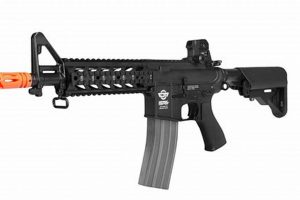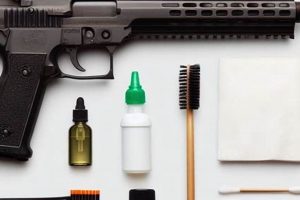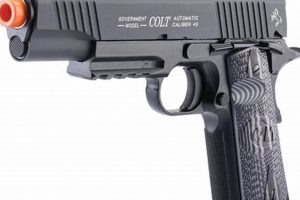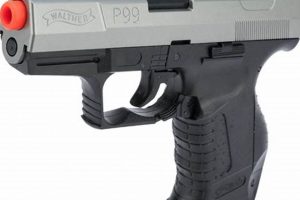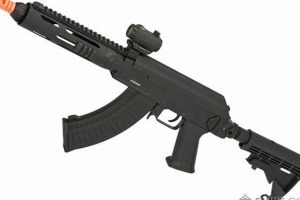These are recreational items replicating real firearms, designed to fire non-lethal projectiles propelled by compressed gas or electricity. These replicas offer enthusiasts a safe and controlled environment for simulated combat and target practice.
The significance of these items lies in their provision of organized recreational activities, promoting teamwork, strategic thinking, and responsible firearm handling in a controlled setting. Historically, the development of such devices has mirrored advancements in firearm technology, adapted for non-lethal applications.
The following sections will delve into the specific characteristics, variations, and operational considerations associated with these recreational products, providing a detailed understanding of their use and maintenance.
Optimizing Performance and Longevity
Proper care and usage are crucial for maintaining operational effectiveness and extending the lifespan of these recreational items. The following guidelines outline key practices for responsible ownership and optimal performance.
Tip 1: Ammunition Selection: Use only high-quality, appropriately sized projectiles recommended by the manufacturer. Inferior ammunition can cause internal damage and reduce accuracy.
Tip 2: Regular Cleaning: Consistent cleaning after each use is essential. Remove debris and residue from the barrel and internal mechanisms to prevent jamming and maintain optimal performance. Use appropriate cleaning solvents as specified by the manufacturer.
Tip 3: Proper Lubrication: Apply silicone-based lubricants to moving parts according to the manufacturer’s recommendations. Avoid petroleum-based products, as they can damage seals and internal components.
Tip 4: Battery Maintenance: For electrically powered models, ensure batteries are fully charged before use and properly stored when not in use. Overcharging or improper storage can reduce battery life and potentially damage the device.
Tip 5: Secure Storage: Store these items in a secure location, away from unauthorized access, particularly children. Use cases or lockable containers to prevent accidental discharge or misuse.
Tip 6: Chronograph Testing: Regularly test the device’s velocity using a chronograph to ensure it remains within established safety limits for the designated playing field. Adjustments may be necessary over time to maintain compliance.
Tip 7: Professional Servicing: Schedule regular servicing by a qualified technician to address potential issues and ensure proper functioning. Preventative maintenance can significantly extend the lifespan and reliability of the device.
Adhering to these practices will contribute to improved performance, enhanced safety, and prolonged durability of these recreational items. Neglecting these guidelines can result in diminished effectiveness, increased maintenance costs, and potential safety hazards.
The concluding section will provide an overview of legal and ethical considerations associated with the ownership and use of these recreational products.
1. Performance
The operational effectiveness of airsoft replicas is directly correlated with their design and construction. Factors such as internal mechanics, barrel quality, and power source determine projectile velocity, accuracy, and range. Higher-performing models exhibit consistent shot-to-shot consistency and minimized deviation, leading to enhanced target acquisition and engagement capabilities. Conversely, substandard components or inadequate construction can result in diminished performance, characterized by reduced range, inconsistent accuracy, and potential malfunctions. For instance, a precisely machined hop-up unit contributes significantly to projectile trajectory, while a poorly sealed air compression system diminishes power output.
Performance characteristics directly influence the tactical applications and competitive viability of these devices. In organized airsoft scenarios, users rely on consistent and accurate shot placement to achieve objectives. Therefore, models exhibiting superior performance offer a distinct advantage in terms of target engagement and strategic positioning. Furthermore, performance impacts the realism of the simulation, with higher-performing models more closely mimicking the handling and ballistic characteristics of real firearms. This enhanced realism contributes to a more immersive and engaging experience.
Optimizing performance requires a multifaceted approach encompassing component selection, maintenance practices, and operational techniques. Selecting models with high-quality internal components, adhering to recommended maintenance schedules, and employing proper aiming and firing techniques are essential for maximizing operational effectiveness. Neglecting these factors can compromise performance and diminish the overall value and utility of these recreational items.
2. Durability
The operational lifespan and consistent performance of airsoft replicas are critically dependent on their inherent durability. Robust construction, high-quality materials, and meticulous manufacturing processes are essential for withstanding the stresses of repeated use and maintaining operational effectiveness over extended periods.
- Material Composition
The choice of materials directly impacts resistance to wear, impact, and environmental factors. High-grade polymers, reinforced metals (e.g., aluminum alloys, steel), and composite materials contribute to structural integrity and resistance to degradation. For example, a metal gearbox shell is more resistant to stress from internal components than a plastic one. The selection of appropriate materials is paramount in ensuring long-term operational reliability.
- Construction Techniques
Manufacturing processes, such as precision molding, tight tolerances, and reinforced assembly methods, play a crucial role in overall durability. Securely fastened components, properly aligned internal mechanisms, and robust external housings minimize the risk of damage during use. For instance, utilizing screws with thread-locking compounds prevents loosening due to vibration. Well-executed construction techniques contribute significantly to the overall robustness of these devices.
- Stress Points and Reinforcement
Certain areas are inherently more susceptible to stress, such as the receiver, barrel assembly, and trigger mechanism. Reinforcement of these critical stress points through the use of thicker materials, strategically placed bracing, or specialized designs enhances resistance to breakage or deformation. An example includes reinforcing the area around the charging handle slot on the receiver to prevent cracking. Targeted reinforcement is crucial for mitigating potential failure points.
- Environmental Resistance
Exposure to environmental elements, such as moisture, dust, and temperature fluctuations, can accelerate degradation and compromise functionality. Corrosion-resistant coatings, sealed components, and weather-resistant materials mitigate the effects of environmental exposure. For example, using a phosphate coating on metal parts prevents rust formation. Environmental resistance extends the operational lifespan and maintains consistent performance in diverse conditions.
The interplay of these factors directly determines the long-term viability and consistent performance of airsoft devices. Investments in models constructed with durable materials, robust construction techniques, reinforced stress points, and environmental resistance translate to enhanced reliability, reduced maintenance requirements, and an extended operational lifespan. Compromising on durability can result in frequent repairs, diminished performance, and ultimately, a shortened service life.
3. Customization
The capacity for modification constitutes a significant aspect of the airsoft replica market. The capacity to alter components and configurations enables users to tailor these devices to specific operational requirements and personal preferences.
- External Modifications
Alterations to the external components, such as stocks, handguards, and sights, allow for enhanced ergonomics and improved target acquisition. Aftermarket stocks, for example, may provide adjustable length-of-pull or cheek rests, accommodating various body types and shooting styles. Similarly, the installation of different sights, such as red dot optics or magnified scopes, can improve accuracy at varying ranges. These modifications are purely aesthetic.
- Internal Upgrades
Enhancements to the internal mechanisms, including gearsets, motors, and barrels, can significantly influence performance metrics. Upgraded gearsets may improve rate of fire and trigger response, while enhanced motors can deliver increased torque and power. Precision inner barrels can contribute to improved accuracy and range. These internal modifications are generally unseen, yet functionally important.
- Accessory Integration
The integration of various accessories, such as tactical lights, lasers, and grenade launchers, expands the operational capabilities of these recreational items. Tactical lights improve visibility in low-light environments, while lasers provide a point-of-aim reference. Grenade launchers, while typically firing non-lethal projectiles, add a tactical dimension to engagements. A variety of accessories can be added or removed without altering the core function.
- Cosmetic Personalization
The application of custom paint schemes, decals, and engravings allows users to personalize the aesthetic appearance. Camouflage patterns can enhance concealment in specific environments, while custom engravings add a unique identifier. This personalization is limited to visual modifications.
The degree of customization available to enhance visual appearance and functional performance contributes to the appeal and utility of the equipment in the airsoft market. The capacity to modify these items provides users with a means of adapting them to specific tactical requirements and personal aesthetic preferences, making them suitable for a variety of applications and scenarios. A range of aftermarket parts contributes to the modular nature of the airsoft products.
4. Maintenance
Consistent upkeep directly influences the operational lifespan and performance consistency of airsoft devices. Neglecting routine maintenance leads to a cascade of negative effects, including diminished accuracy, reduced power output, and increased susceptibility to malfunctions. For instance, failure to regularly clean the inner barrel results in projectile deviation due to accumulated residue. Similarly, inadequate lubrication of internal components accelerates wear and tear, leading to premature failure. A well-maintained airsoft device, conversely, exhibits optimal performance, extended service life, and reduced risk of unexpected failures during operation. Cleaning is an effective strategy.
Specific maintenance procedures vary depending on the model and its operating mechanism. Electrically powered models require regular inspection of battery connections and motor brushes. Gas-powered models necessitate careful attention to valve seals and gas routing systems. Regardless of the type, routine disassembly, cleaning, lubrication, and inspection are essential. Consider a device used in outdoor environments where exposure to dirt and moisture is common. More frequent maintenance intervals are required to prevent corrosion and maintain performance. Preventative steps can also increase longevity and performance.
The understanding of maintenance as a critical component of responsible ownership is paramount. Proper maintenance not only preserves the investment in the equipment but also ensures safe and reliable operation. Resources such as manufacturer’s manuals and online tutorials offer detailed guidance on specific maintenance procedures. Regular adherence to these guidelines ensures that airsoft devices remain in optimal condition, providing years of reliable service. Neglect of maintenance can lead to irreversible damage and potential safety hazards.
5. Regulations
The ownership, sale, and use of airsoft replicas are subject to varying legal restrictions across jurisdictions. These regulations aim to ensure public safety and prevent misuse. Failure to comply can result in legal penalties, including fines, confiscation of equipment, and, in some cases, criminal charges. For instance, some regions mandate the use of blaze orange barrel tips to distinguish these items from actual firearms, while others impose restrictions on their public display or transportation. These regulations represent a framework to mitigate risks associated with the potential for misidentification or misuse.
Specific examples of regulatory differences include variations in permissible projectile velocity, minimum age requirements for purchase or use, and restrictions on playing locations. Some municipalities classify airsoft replicas as imitation firearms, subjecting them to the same regulations as real firearms. Conversely, other jurisdictions treat them as toys, with minimal restrictions. In certain European countries, for example, the maximum permissible projectile energy is strictly regulated, requiring manufacturers to adhere to specific standards. These varied regulations necessitate that consumers are responsible and fully conversant with the applicable laws in their specific locations.
Understanding and adhering to applicable regulations are essential for responsible ownership and usage. Lack of awareness does not excuse non-compliance. Consumers are advised to consult local authorities, legal professionals, or regulatory agencies to ensure full compliance with all relevant laws and ordinances. The goal is to foster a responsible airsoft community where safety and compliance are prioritized to ensure the continued legality and accessibility of the activity.
6. Safety
The inherent design and operational characteristics of airsoft replicas necessitate a stringent emphasis on safety. The potential for projectile impact, even with non-lethal rounds, poses a risk of injury to the eyes, skin, and other vulnerable areas. Consequently, adherence to established safety protocols is paramount to mitigating these risks and ensuring a safe recreational environment. For example, the mandatory use of ANSI-rated eye protection is universally recognized as a critical preventative measure against ocular injuries. The absence of such protective gear significantly increases the likelihood of serious harm.
Safe handling practices extend beyond protective equipment to encompass responsible behavior and awareness of surroundings. Maintaining a safe firing distance, avoiding aiming at unprotected individuals, and properly storing the devices when not in use are essential components of responsible airsoft operation. In organized airsoft events, marshals enforce these safety rules, penalizing participants who violate established protocols. Such disciplinary actions serve to reinforce the importance of safety and prevent potential accidents. Instances of accidental discharge or misuse often stem from a lack of proper training and adherence to these fundamental safety principles.
The integration of safety mechanisms, such as functional safety switches and velocity limiters, contributes to minimizing the risk of accidental or unintended harm. Regular inspection of these mechanisms is essential to ensure proper functioning. The proper use of a chronograph to verify velocity compliance with field regulations prevents instances of over-powered replicas causing injury. Prioritizing safety through adherence to established protocols, responsible handling practices, and the utilization of built-in safety mechanisms is essential for responsible and sustainable airsoft recreation.
7. Realism
The pursuit of verisimilitude is a central aspect of the airsoft experience. The degree to which these recreational items replicate the appearance, handling, and operation of actual firearms significantly impacts the immersion and tactical training value derived from their use.
- Cosmetic Accuracy
The external replication of real-world firearms is a primary focus. Dimensions, contours, and markings are often meticulously recreated to mirror their authentic counterparts. Examples include faithful reproductions of specific firearm models, complete with licensed trademarks and accurate component placement. This visual fidelity enhances the immersive experience and appeals to collectors and enthusiasts seeking authentic replicas. It could also include replicating paint jobs and materials to match the real one.
- Operational Similarity
Beyond aesthetics, the replication of operational mechanics contributes to the realistic experience. This includes features such as functioning charging handles, realistic magazine capacities, and simulated recoil. The operation of the replica should mimic the real-world model as closely as possible, including how the user loads, aims, and fires the gun. The weight and balance are also a part of the operational aspect of it.
- Ballistic Simulation
While airsoft projectiles are non-lethal, the simulation of ballistic characteristics plays a role in the overall sense of realism. Projectile trajectory, range, and impact force are often tuned to approximate the behavior of real-world projectiles within the constraints of safety. High-performance models, for example, may exhibit flatter trajectories and greater effective range, mimicking the capabilities of actual firearms. This helps users learn and adapt their gameplay style and strategic planning to be like the real one.
- Tactical Applications
The realistic design of airsoft replicas facilitates tactical training and scenario-based exercises. Law enforcement agencies, military units, and private security firms utilize these devices for force-on-force training, benefiting from the accurate representation of real-world firearms. The ability to realistically simulate tactical scenarios allows for practical skill development and refinement in a safe and controlled environment. This allows to safely practice how to hold a firearm in a proper stance and tactical maneuvers.
The level of realism contributes significantly to the appeal and practical utility of airsoft. From collectors seeking authentic replicas to tactical trainers utilizing them for skill development, the degree to which these recreational items mirror their real-world counterparts enhances the overall experience and value. Any part of a real firearm that a airsoft product has can also add or take away from the realism.
Frequently Asked Questions About Red Wolf Airsoft Guns
The following section addresses common inquiries and misconceptions regarding these specialized recreational items. The intent is to provide clear, factual information for prospective users and enthusiasts.
Question 1: What distinguishes these airsoft replicas from conventional toys?
These devices are designed to replicate real firearms in appearance and operation, often incorporating intricate internal mechanisms and realistic external features. Conventional toys typically lack this level of detail and operational fidelity. Furthermore, these items are intended for organized recreational activities and tactical training simulations, requiring responsible use and adherence to safety protocols.
Question 2: Are there specific legal requirements associated with owning a these recreational items?
Legal restrictions vary significantly across jurisdictions. These regulations may include minimum age requirements, restrictions on public display or transportation, and limitations on projectile velocity. Compliance with all applicable local, regional, and national laws is mandatory. Failure to adhere to these regulations may result in legal penalties.
Question 3: What type of maintenance is required to ensure proper functioning?
Routine maintenance includes regular cleaning, lubrication of moving parts, and inspection for wear or damage. Specific procedures vary depending on the model and its operating mechanism. Adherence to the manufacturer’s recommended maintenance schedule is crucial for optimal performance and longevity.
Question 4: Can these airsoft replicas be modified or customized?
Many models offer a range of customization options, including external modifications (e.g., stocks, sights) and internal upgrades (e.g., gearsets, barrels). These modifications can enhance performance, improve ergonomics, and personalize the aesthetic appearance. However, modifications should be performed responsibly and within legal limits.
Question 5: What safety precautions should be taken when using these devices?
The mandatory use of ANSI-rated eye protection is paramount. Safe handling practices include maintaining a safe firing distance, avoiding aiming at unprotected individuals, and properly storing the device when not in use. Awareness of surroundings and adherence to established safety protocols are essential.
Question 6: Where can one obtain information regarding responsible ownership and usage?
Resources include manufacturer’s manuals, online forums, and organized airsoft communities. These resources provide valuable information on safety protocols, maintenance procedures, legal requirements, and ethical considerations. Engaging with experienced users and adhering to established best practices promotes responsible and safe airsoft recreation.
In summary, responsible ownership and usage of these recreational items necessitate compliance with legal requirements, adherence to safety protocols, and a commitment to routine maintenance. Informed decision-making and responsible behavior are essential for a safe and enjoyable airsoft experience.
The concluding section will provide resources and references for further exploration of this topic.
Conclusion
This exploration has provided a comprehensive overview of recreational items emulating firearms, highlighting characteristics, maintenance, legalities, and safety. The analysis underscores the significance of performance, durability, customization options, and realism in responsible ownership and operation. Furthermore, adherence to established regulations and safety protocols has been consistently emphasized to ensure the well-being of participants and the public.
Responsible engagement requires ongoing awareness and adherence to evolving standards. Prospective owners and enthusiasts are urged to prioritize safety, comply with all applicable laws, and promote ethical conduct within the airsoft community. Sustained diligence will safeguard the integrity of this recreational pursuit and ensure its continued accessibility for future generations.


![Airsoft Legality: Risks of Orange Tip Removal [Guide] Ultimate Airsoft Guide for Beginners, Tactics & Gear Reviews Airsoft Legality: Risks of Orange Tip Removal [Guide] | Ultimate Airsoft Guide for Beginners, Tactics & Gear Reviews](https://airsoftica.com/wp-content/uploads/2025/10/th-990-300x200.jpg)
